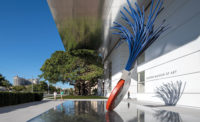Zurich, Switzerland
ARGE Grazioli Krischanitz
In 1849, Richard Wagner fled Germany for Zurich, escaping retribution for his political involvement in the May Uprising against the Saxon government. Although the composer and Dresden Opera conductor finished the libretto for his Ring Cycle at the start of his exile, the period was volatile, marked by poverty and his wife, Minna’s, worsening depression. Yet in 1852, Wagner met silk merchant Otto Wesendonck, who took him under his wing, and by the middle of the decade Wagner was residing at his wealthy benefactor’s villa—designed by architect Leonhard Zeugheer in 1857 on 16.5 acres overlooking Lake Zurich.
Today, the Wesendonck Villa is known as the Rietberg Museum, founded in 1952 to house the collection of banker Eduard von der Heydt at the estate, now owned by the city of Rietberg. The collection of art and artifacts gathered outside Europe ranges from 3rd-century Indian religious figurines to 16th-century Persian illustrations to paintings from China’s Qing Dynasty. Over time, the permanent collection grew to nearly 4,000 objects, and the historic building proved too small to accommodate the institution’s artifacts as well as traveling exhibitions. In 2002, museum officials, working with Switzerland’s Land Bureau for the Conservation of Historic Monuments, held a competition for the design of an addition. The firm of Berlin-based architect Alfred Grazioli and Viennese architect Adolf Krischanitz, both professors at the Berlin University of the Arts, was selected. The architects’ foremost concern was to leave Zeugheer’s original architecture and landscape largely undisturbed, even though they proposed adding 17,000 square feet to the museum, twice the area of the Wesendonck Villa. But in the manner of Renzo Piano’s expansion of the Morgan Library and Museum in New York City [record October, 2006, page 93], or the Steven Holl–designed wing for the Nelson-Atkins Museum of Art in Kansas City, Missouri [record July 2007, page 92], Grazioli and Krischanitz chose to submerge 80 percent of the addition. Buried underground, except for one visible glass elevation, today the Emerald, as it is called, plunges 39 feet below the surface of Moränen Hill, a slight bump adjacent to the former main residence. The scheme allows visitors to stroll around the parklike grounds much as the Wesendoncks once did.
Although the parti is unassuming, its execution was anything but. In order to construct the subterranean structure, crews excavated the swath of land separating Moränen Hill from the western elevation of the Wesendonck Villa, partially removing the hill itself, and propping the historic house on a steel armature. Once braced, the addition was erected in poured-in-place reinforced concrete, the only evidence of which are two crisp concrete retaining walls built into the hill. These wedges also frame the addition’s entry elevation, a series of highly ferrous (hence green) glass panes held tight by structural-glass fins.
Moreover, while the diminutive scale of Grazioli and Krischanitz’s visible strokes pay homage to the original estate, exterior details suggest other associations. The glass facade, for example, features an enamel pattern of darkened triangles radiating from hexagons. The west elevation of the villa is distinguished by a lacy iron canopy sheltering an equally ornate balustrade, and Krischanitz wanted the glass pattern to contrast with the historic building, yet demonstrate “a strong connection between the refinement of detail in the villa and the pavilion.” The geometry of the glass pattern, which matches the scale of the balustrade, also suggests crystalline facets, or even the historic Persian decoration seen in paintings on view in the museum.
Such richness of detail recurs inside the new addition. The courtyard connecting the original villa and the Emerald is covered in end-grain acacia pavers, which continue into the Emerald’s spacious, all-glass antechamber. The main room that sits immediately behind it—loosely divided into coat-check, retail, and ticket-sales spaces—terminates in a concrete bas relief with gold-leaf imprints by artist Helmut Federle, which runs the width of the space. This foyer’s cavelike atmosphere prepares the visitors for the galleries underground. The ceiling, composed of fluorescent-backlit panels of highly figured onyx, reinforces the subterranean ambience.
Two gallery floors stacked beneath the Emerald’s introductory level display works in the permanent collection and temporary exhibitions. Besides multiplying the Rietberg Museum’s exhibition space, this area introduces a new paradigm for exhibiting the collection. The permanent collection shown in the Wesendonck Villa, which received new paint and plaster for the reopening, is arranged as miniature essays responding to the proportions of the home’s original rooms. Pieces displayed among the new addition’s expansive exhibition spaces, on the other hand, are not scaled to a domestic context, and uninterrupted sight lines and circulation allow visitors to forge linkages between artifacts from disparate cultures. Krischanitz and Grazioli achieve this more detached arrangement without asceticism. The rooms are divisible, ceilings are brilliantly backlit, end-grain oak floors provide warmth, and a dramatically illuminated stairwell sheathed in an oak screen punctuates the galleries. A second set of stairwells connects the expansion to the original villa from below.
Wagner’s stay at the Wesendonck Villa in the 1850s was tumultuous. There he grew infatuated with Otto Wesendonck’s wife, Mathilde; abruptly interrupted composing the Ring Cycle; wrote the Wesendonck Lieder, music for five of Mathilde’s poems (which make reference to emeralds); and began work on Tristan und Isolde, his renowned interpretation of the medieval adultery legend.
As the home of the Rietberg Museum, the Wesendonck Villa is no less charged than when Wagner was there. With a design that embraces contrasts, from the precise facade set against the lush topography to the different styles of exhibition display, Grazioli and Krischanitz’s addition acknowledges the contradiction between the historic Swiss setting and the exotic nature of its collection. And like Wagner, the architects have tapped into this electricity to produce a self-confident work of art.



Post a comment to this article
Report Abusive Comment